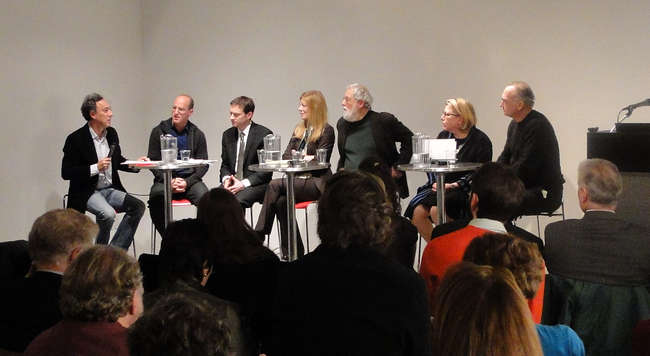
As visitors to the Center for Architecture—the Lower Manhattan home of the New York Chapter of the American Institute of Architects (AIANY)—awaited the start of a panel called "Designing the City after Superstorm Sandy," they took in a photo that was projected on the screen depicting an image all too familiar these days: Debris piled up in the middle of a residential street, left behind from Sandy’s unprecedented storm surge. There were audible gasps and groans in the standing-room-only crowd when the AIANY 2012 president Joseph Aliotta, revealed in his opening remarks that the picture was taken right outside his home in Staten Island. While his house was spared serious damage, many of his neighbors were not so lucky. "Many lost their homes and, others, their lives," he said.
 |
| Photo courtesy Center for Architecture Kimmelman, giving his introductory remarks in front of an image taken in AIANY 2012 president Joseph Aliotta's Staten Island neighborhood. |
Such is the state of affairs across the region, which was walloped by the category 1 hurricane that made landfall on October 29. Water surged to heights of 14 feet in Lower Manhattan’s financial district, and communities in Queens, Staten Island, and Brooklyn suffered extensive flooding and infrastructure damage.
New York Times architecture critic Michael Kimmelman moderated the panel, which comprised a diverse group from the fields of city government, architecture, landscape design, and academia and addressed the numerous difficult questions of planning for life in the region after the hurricane: What is the role of designers and architects in the rebuilding effort? How can the private and public sectors work together quickly and intelligently? Can we safely reconstruct seaside residential communities that are likely to flood again over the next decade, or should city and federal officials encourage relocation?
The six panelists included Cynthia Barton, housing recovery plan manager at the Office of Emergency Management; Howard Slatkin, director of sustainability with the New York City Department of City Planning; Dr. Klaus Jacob, a geophysicist and professor of disaster risk management at Columbia University; Stephen Cassell, a principal at New York-based Architecture Research Office (ARO); Donna Walcavage, a landscape architect with AECOM; and Rob Rogers, founding partner of New York’s Rogers Marvel Architects. Each viewed the looming issue of reconstruction from a perspective that corresponded with his or her area of expertise, but all agreed that a concerted partnership between big-idea firms like ARO and Rogers Marvel and nuts-and-bolts city government agencies would be crucial for any real progress to occur.
So, what do we do? Build barriers at the mouth of New York Harbor? Install inflatable "plugs" at the openings of the region’s seven tunnels for subway transit? Create marshlands and oyster beds to impede the force of incoming storms? Each of these ideas was proposed as a potential solution for short- and long-term disaster preparedness, but “we’re going to need to gather the resources of a variety of city and regional agencies,” noted Kimmelman, who expressed skepticism about the national public’s attention span and the real capabilities of government officials.
Getting the rebuilding effort underway in earnest will test our ability to respond to the reality of an increased frequency of extreme weather phenomena, rather than act on our emotions, argued Jacob. Rogers agreed. Noting the staggering number of design challenges created by climate change, he asserted that in New York "the economic drive exists to create a positive change that is proactive." While companies like Goldman Sachs and other financial titans in Lower Manhattan have a clear vested interest in protecting their assets, the city of New York also wants to retain its tax base, said Kimmelman. Keeping those taxpayers is good for the whole city, from Staten Island’s devastated Midland Beach neighborhood to the inundated Red Hook section of Brooklyn.
Many tough decisions remain, with no simple answers in sight. Fortunately, New York, with its financial resources and community of architects, planners, and engineers, is a prime testing ground for solutions both large and small. Discussions like this one provide platforms for generating ideas and, perhaps more importantly, assembling a diversity of voices in one room. In Kimmelman’s words, the effort to rebuild the region "will be a test of our democracy."

Post a comment to this article
Report Abusive Comment